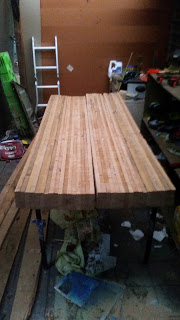Some of you may have seen on facebook that I have been building a workbench from mostly stuff that would otherwise get thrown away.
It started out as 3.6m long pallets that work needed to get rid of. So I took a couple to disassemble into more useful parts. I've used the planking from the top and bottom and made sure that I took out all of the nails. I then glued the faces of each of these together until I had a big enough block of timber. I then cut this in half so the bench would be a sensible size for my workspace.
The ends are not quite even because there were some chunks out of the ends of some planks. I put all of these at one end so I could cut off the worst of it all at once.
It looks a lot worse in this picture than in person. But I planed down the biggest misalignments and glue runs on what would become the top.
Then it was time to get ready for the glue up. To make sure that I didn't glue the bench to the sawhorses I put some pallet wrap around them.
Doing a dry fit to make sure there wouldn't be any gaps one everything was pulled up.
You can just see some light through here. This needed to get fixed.
To fix it I found the high spot and just took a little material off with the plane until it was pretty even on the straightedge.
Here we are, gluing in process. I put some pallet wrap around the joint as well to stop drips landing on the ground and on my straps.
Unfortunately I did have a little split open up during gluing. I think this was because I tightened the straps differently which meant that the one at this end would have been slightly slacker. I'm not worried about this as I can either chop out a section and inset a new piece, or more easily I can make an appropriate wedge and glue that in there.
Because I didn't plane down or level off the bottom side of the table at all I needed to cut rebates through the high points for the cross bars of the frame I am using. To mark them I used a chisel.
And this is the hammer I have been using with the chisel. Yes it is just a random hunk of wood. And yes there are characteristics it has that I would like to be different. But it works surprisingly well, is not heavy enough to be tiring and I don't need to worry about breaking or wearing it out as I can very easily find another just as good.
I cut down along the marked lines with a saw to about the depth of the lowest plank. Then I chopped out the middle with the chisel. It probably would have been easier if I'd made the trench a bit wider so it was the same width as the chisel. That would have made it much easier to get a nice clean even trench. As it was, it wasn't too bad.
And there you have it. There is still some work to be done in making it nice and flat and even. But at this point I need a workbench and this is now flat enough for me to start using it.
I even have it covered in stuff already.
Cheers,
Rex

















Comments powered by CComment